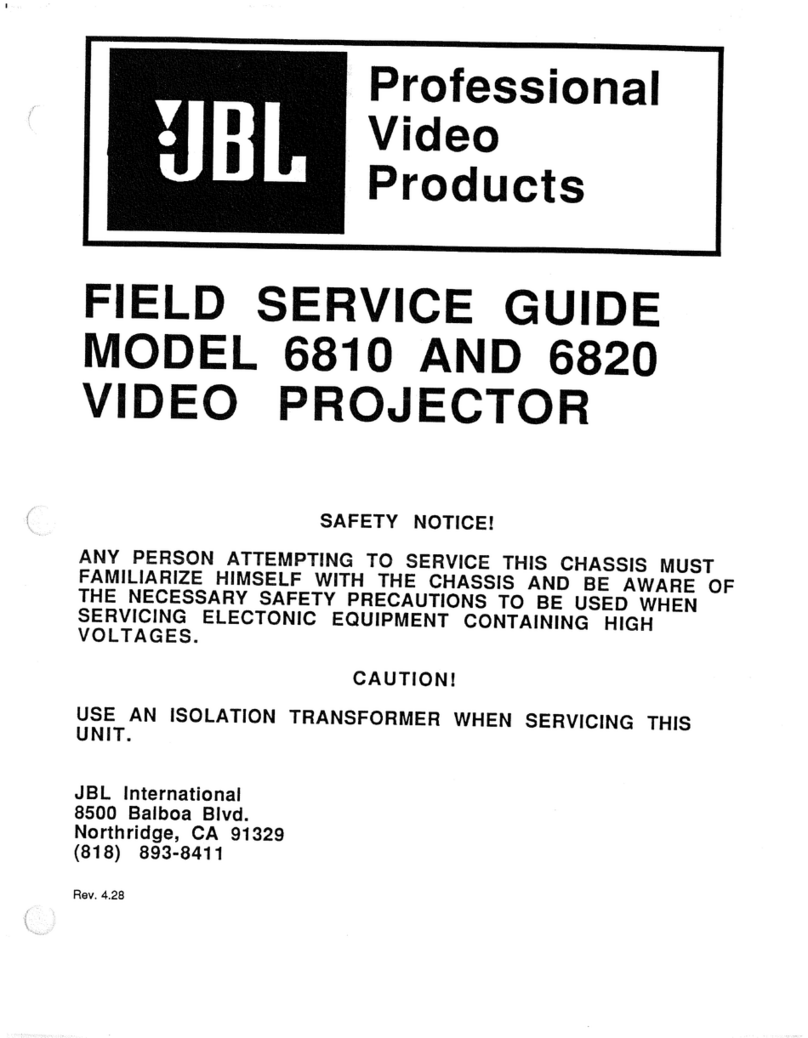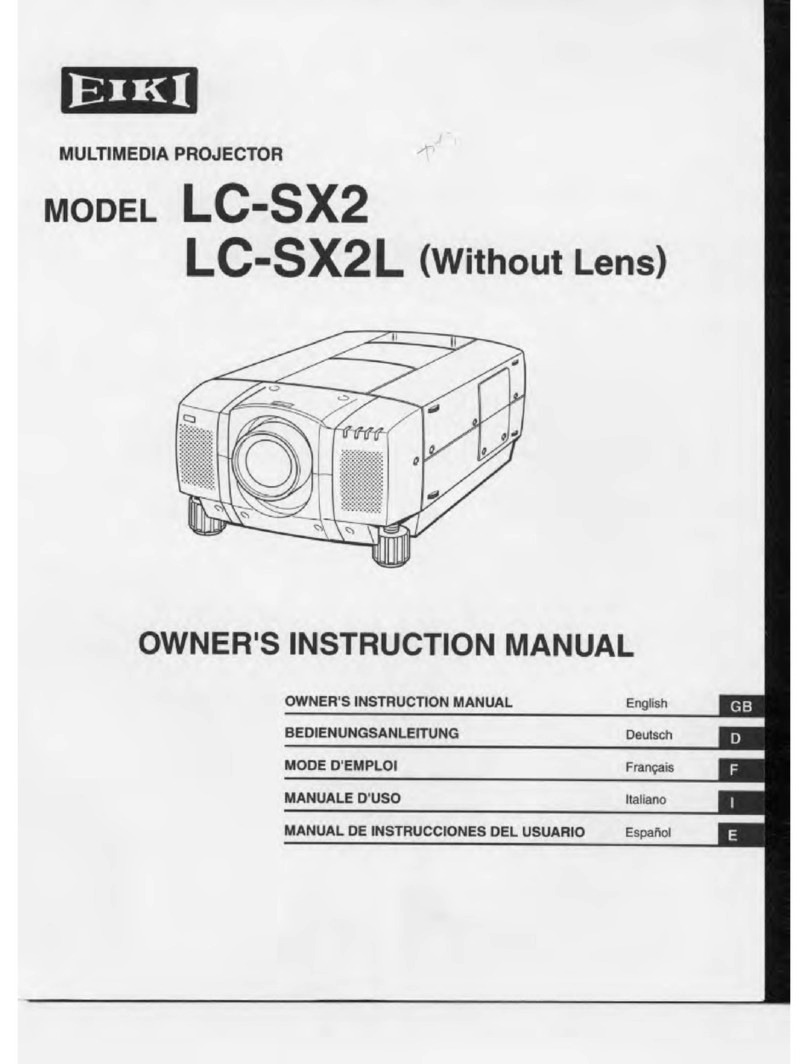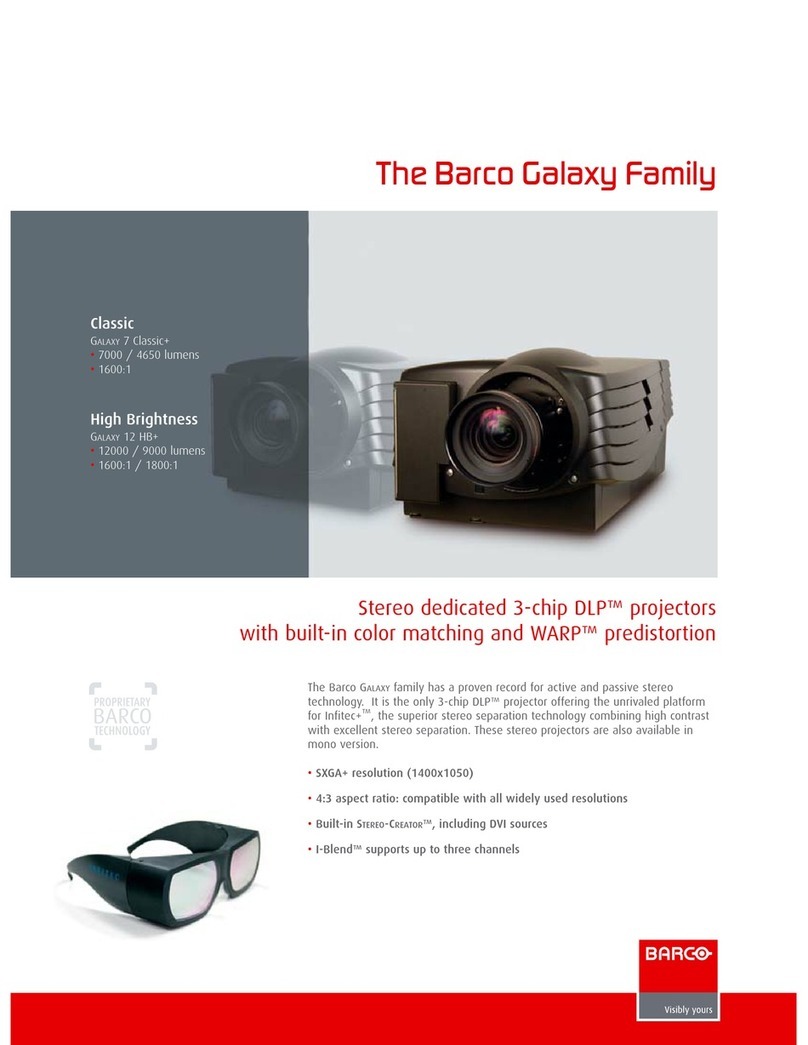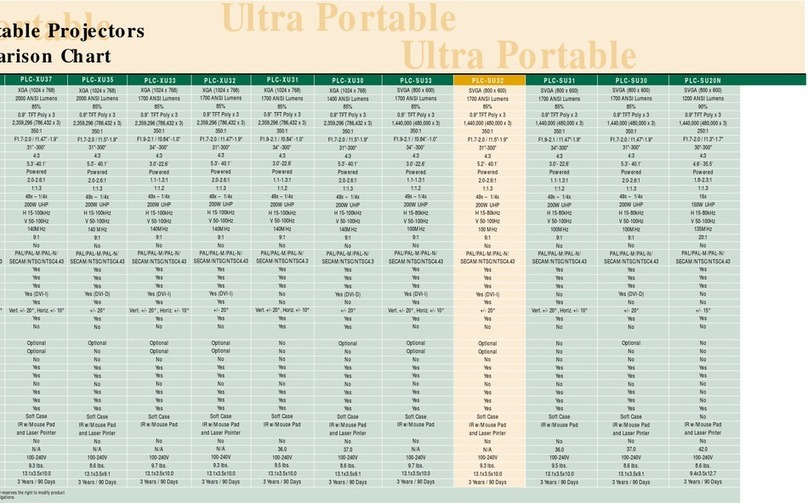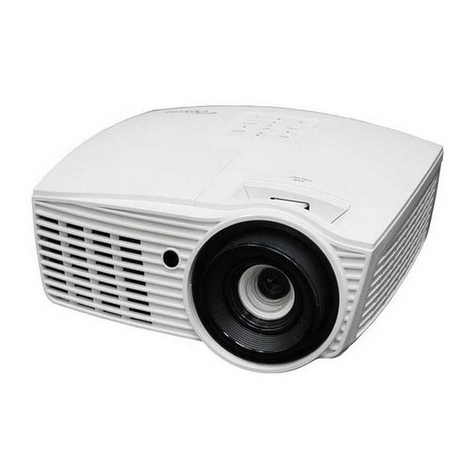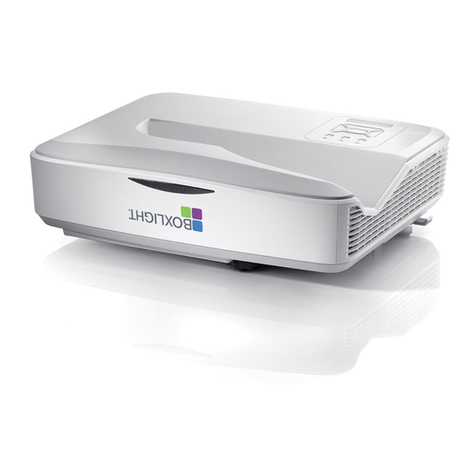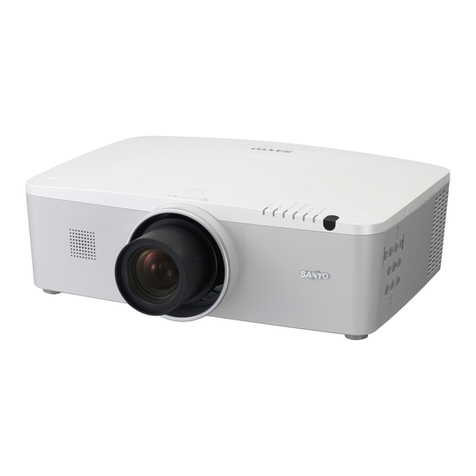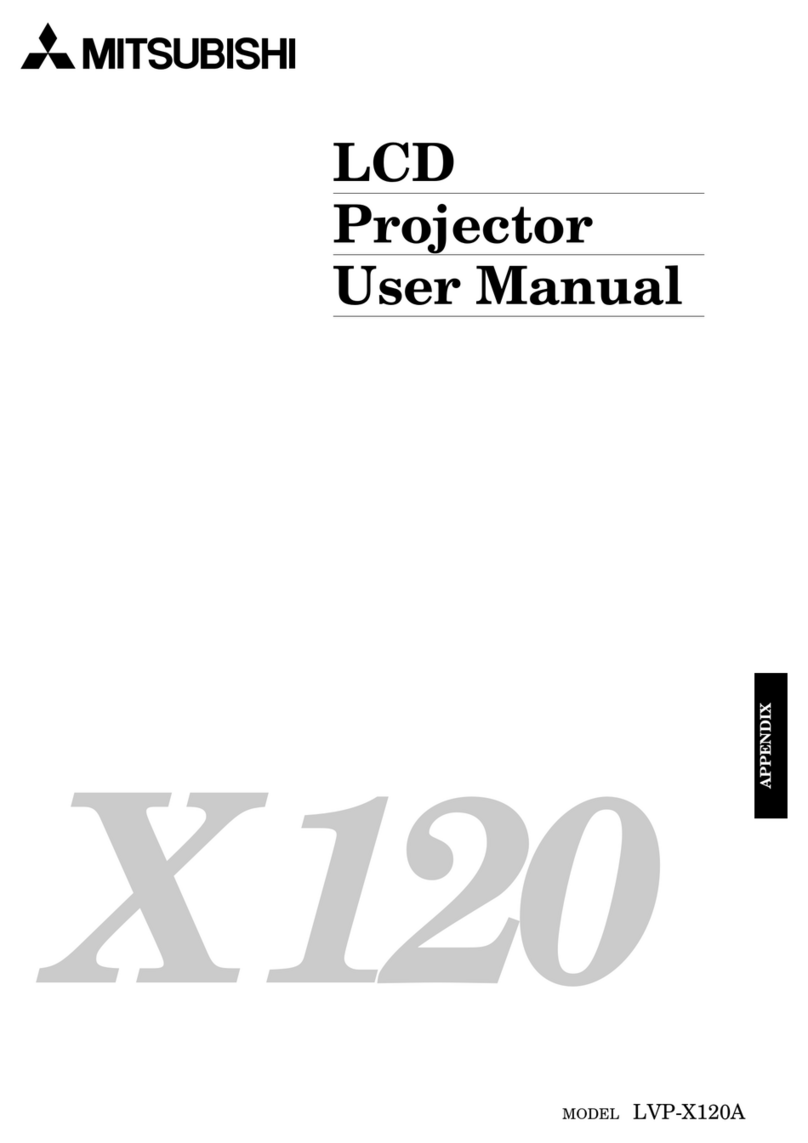JBL 6810 Installation guide

Professional
Video
Products
TECHNICAL
TRAININGMANUAL
MODEL6810AND6820
VIDEOPROJECTOR
JBLInternational
8500BalboaBlvd.
Northridge,CA91329
(818)
893-8411
JBL

CONTENT
SubjectPage
SignalFlowBlockDiagram3
PowerSupplyPanel4
SwitchedRegulator6
HighVoltageRegulator7
DeflectionPanel8
HorizontalSweepCircuits8
VerticalSweepCircuits9
OverloadProtectionCircuits10
TS10TuningSystem11
RFSwitcher18
IFModule16
Stereo/SAPDecoderModule17
TunerInterfacePanel20
input/OutputPanel22
AudioSwitchingCircuits23
Video/SyncSwitchingCircuits23
RGBSwitchingCircuits24
ComputerIntensityBitSwitchingCircuits25
InsertVideoSwitchingCircuits25
SoundProcessingModule& StereoAmplifier26
CombFilterModule28
VideoProcessorPanel30
AutoSharpnessControl30
VideoProcessingCircuits31
ChromaProcessingCircuits31
SandCastleGenerator31
RGBProcessingCircuits32
VerticalSweepFailSafeCircuits32
CRTDrivePanel33
ConvergencePanel35
HorizontalDelayModule35
ConvergencePanelVoltageSource37
SawtoothGenerator37
HorizontalWaveformAmplifier38
VerticalWaveformAmplifier38
Top/BottomPincushionGenerator39
Trapezoid/KeystoneGenerator39
SidePincushionGenerator41
ConvergenceOutputAmplifiers41
CrosshairGenerator41

Figure1 - SignalFlowBlockDiagram

Signal
Flow
BlockDiagram
ThemajorfunctionsoftheprojectionTVsystem
areshownintheOverallBlockDiagram,Figure
1.
TheselectedRFsignalisfedfromtheRF
SwitchertotheTunerandconvertedtoVideoIF.
TheIFModule,locatedontheTunerInterface
PaneldetectsbothCompositeVideoandwideband
AudiofromtheIFsignal.Theaudiosignalisfed
totheStereo/SAPDecoderModule,whichchecks
forbothStereoPilotandSAPFMcarriers.To
selecteitherStereoorSAPAudio,theapprop-
riatebuttonontheAudioSelectKeyboardis
pressed.
Associatedlogiclevelsaresentfromthe
TunerInterfacePaneltotheStereo/SAPDecoder
andtheAudioProcessingModuletoselectthe
modeofoperation.TheselectedAudioisdecoded
andfedtotheI/OPanelTunerAudioinput
J712-1,
-3whereitisbuffered,switched,and
outputat
J718-1,
-4.TheAudioProcessing
Module,locatedontheStereoPowerAmplifier,
processestheselectedAudio.IftheStereobutton
wasnotpressed,theinputstotheAudio
ProcessorremainintheMonauralmode.Audio
Volume,Bass,andBalancecontrolsadjustthe
drivetotheStereoPowerAmplifier.
DetectedVideofromtheIFModuleisfedthrough
theTunerInterfacePanelJ32toI/OPanel
J707,
theTunerVideoInput.TheComposite
Videosignalisamplified,switched,buffered,and
outputatJ717forVideoprocessingandJ709
forSyncprocessing.TheCompositeVideois
processedintoLuminance,VerticalDetail,and
Chromasignals.LuminanceandVerticalDetail
signalsarematrixedandoutputatP501-5,-6,
andChromaisoutputatJ501-10.
TheVideoProcessorPanelreceivespositive
Video,negativeVideo,andChromafromtheComb
Filter.Thesesignalsareprocessedintodecoded
R,G,andB Video,thenbufferedandfedfromthe
VideoProcessorPaneloutputsJ406,J405,and
J404toI/OPanelinputsJ708,J706,J705
respectively.AdditionalR,G,andB signal
processingaddsDCRestoration,BlackLevel,
SandCastle,andVerticalandHorizontal
Blanking.
TheprocessedR,G,andB signalsare
bufferedandfedtotheindividualCRTsthrough
theCRTDrivePanels.
HEATSINK
HVDRIVER
Q11J
HEATSINK
SWITCHED
REGULATOR
Q10
STAND-BY
POWERTRANSFORMER
T1
TP9
HEATSINK
HVREGULATOR
Q14
NSFORMER
FORMER
SWITCHING
TRANSFORMER
T3
Figure2 - PowerSupplyPanel

PowerSupplyPanel
Thelocations
of
majorcomponentsonthePower
Supply
are
shown
in
Figure
2.
Starting
inthe
lowerleft,they
are:
Stand-By
and
Start-Up
PowerTransformer;above
isthe
heatsink,
SwitchedRegulator,
and
SwitchingChoke;then
the
HV
Transformer,
HV
Driver,
HV
Regulator
andheatsink;
onthe
right
isthe
Panelpin-outs;
below
is
thePowerRelay.
TheBlockDiagram,Figure
3,
shows
the
basic
blockfunctions
of
thePowerSupplyPanel.
The
PowerSupplyproducesninevoltages
(twoof
which
are
regulated),
andone
ErrorLatch
circuitprovidesover-current
and
over-voltage
shutdown.
120Vac
is
appliedfrom
theAC
Interconnectboard
tothe
RelaySwitchRY1,
the
12VdcStand-Bysupply,and
the
24VdcStart-Up
supply.The12VdcStand-ByPower
is
fed
tothe
TunerControllerandTunerInterfacePanel.
The
24VdcStart-UpvoltageenergizestheDeflection
PanelandTunerController.WhenthePower-On
button
is
pressed,
the
PowerRelayControlline
activatesthePowerRelay,connecting120Vac
to
theVoltageDoubter.
The
310Vdcfrom
the
VoltageDoubler
is
fed
to
theSwitchedRegulator,
whichoutputsthe130Vdcsourcevoltage.
TheDeflectionPaneloutputsHorizontalDrive
pulses
tothe
Optic-Coupler
and
drives
the
SwitchedRegulator.TheHorizontalDrivepulses
control
theOn
time
ofthe
Regulator
(and,
therefore,theoutputvoltage)
by
means
of
Pulse
WidthModulation(PWM).
The
130Vdcoutput
from
the
SwitchedRegulator
isfedtothe
DeflectionPanelandHighVoltageRegulator.
The
HighVoltageRegulatorcontrolsthe30KVHV
by
regulating
the
117Vdcinput
totheHV
Trans-
former.
The
HorizontalDrivepulses
arefed
from
the
SwitchedRegulator
tothe
Horizontal
Drivecircuit
andthe
HorizontalOutput
transistor
to
developflybackandscanpulses
for
theover-voltageshutdown
andHV
Regulator
circuits.When
an
overloadresultsfrom
an
overvoltage
or
overcurrentcondition,
the
SwitchedRegulator
is
turned
offby
thesignal
on
theshutdownline.
Initially,
the
PowerSupplyPanelprovides
12VdcStand-Byvoltage
tothe
TunerInterface
PanelandtheTunerController.
(20
VAC
AC
INTER-
CONNECT
PANEL
J7,
l,3
I20
VAC
JI03
1,3
HORIZONTAL
DEFLECTION
PAH EL
CVOSVOLTAGE/
•DVEf?tOi'.fl«E*ir"
SHUTDOWN
P2I7
-II
H.
DRIVE
JI07
-4
JI08
-4
POWER
RELAY
POWERSUPPLYPANEL
VOLTAGE
DOUBLER
POWER
SUPPLY
3I0VDC SWITCHED
REGULATOR
(PWM)
I2VSTANDBY
SUPPLY
24VSTART-
UPSUPPLY
I2VDC
24VDC
24VDC
0PT0-
ISOLATOR
COUPLER
SHUTDOWN
JI07
-7
DRIVE
I30V0C
HV
REGULATOR
II7VDC
DRIVE
HV
ADJUST
I0VDC
HV
REGULATOR
REFERENCE
IOV0C
HV
XFMR
!I06
-3 POWERRELAYCONTROL
JI06
-I
TUNER
INTERFACE
PANEL
TUNER
CONTROLLER
TS
JI08
-6,-7
30KV
JIOI
15
KVFOCUS.
J109
V
JI07
2I0V
-i
OVER
VOLTAGE
SHUT-DOWN
>•130VOC
SOURCE
HORIZONTAL
DEFLECTION
PANEL
TOOVER
VOLTAGE
SHUTDOWN
CIRCUIT
Figure
3 -
PowerSupplyBasicBlock
Dia
4

AsseeninFigure4 the12VdcStand-Byvoltage
isappliedtothe5VRegulatorIC500-3whereit
becomestheKeepAlivevoltageforMicro-
computerIC1000.TheRelaycontrolvoltageand
the24VdcStart-Upvoltageareproducedwhen
thePowerbuttonispressed.Thekeypressis
decodedbytheMicrocomputerIC1000intoa
logicLowatpin1,whichturnsOffQ19and
turnsOnQ20.TheswitchingactionofQ20pulls
thePowerRelayRY1,Q3andQ2toground.Q1
conductsandapplies24VdctothePowerRelay.
Therelaylatchesandconnects120Vactothe
VoltageDoubter.Q1alsosupplies24Vdctothe
HorizontalOscillatorModuleandOpticCoupler
IC1onthePowerSupplyPanel.
Apulsetrain,developedbytheHorizontal
JI03-
OscillatorModule,drivestheHorizontalsweep
circuitsandtheSwitchedRegulatoronthePower
SupplyPanel.R5andC10forma twosecond
timing circuit.C10beginstochargetoward
42VdcafterthePowerbuttonispressed.Ifthe
voltageonC10reaches15.8voltsbeforethe
scanderivedvoltagesaredeveloped,zenerZ1
turnsOn.ThisplacesQ3intosaturation,
removesQ2forwardbiasandshutsdownthe
Start-UpSupply.Duringthistimeperiod,if
HorizontalOutputTransformerT2andHV
TransformerT4aredriven,theflybackpulses
arerectifiedandproducethederivedvoltages.A
scan-derived24VdcfromtheDeflectionPanelis
fedthroughdiodeD6to.zener
Z1
andturnsOffQ1
whileintheRunMode.AftertheStand-Byand
Start-Upmodesarecompleted,theRunMode
takesover.
TO
*
VOLTAGE
POWER
D0UBLER
RELAY
URYI
_24VDC
CJTP2TO
.HORIZ
OSCILLATOR
MODULE
DERIVED
24V>
(RUN
MODE)
TS10
CONTROLLER
PANEL
Q19
RELAY
CONTROL
SWITCH
Figure
4 -
Power
On
Circuit

TP6
QIO
SWITCHED
REGULATOR
POWER
ON
AC
COMMON
TO
HVXFMR
T4-I
TO
HV(EHT)
REGULATOR
QI4
FROM
Q8
SHUTDOWN
TP2
LATCH
HORIZPULSE
50/50
+
DUTYCYCLE
J'07
FROM
-4
DEFLECTION
PANELJ215-5
SWITCHED
REGULATOR
POWER
SUPPLY
(PULSEWIDTHMODULATOR)
Figure5 - SwitchedRegulatorCircuit
SwitchedRegulator
In
theRun
Mode,drivepulsesdeveloped
on
the
HorizontalOscillatorModule
arefedtothe
Optic-
CouplerDriver
Q4,
Figure
5.
The
50/50duty
cyclepulsetrain
is
fed
from
the
DeflectionPanel
throughJ215-5
and
PowerPanelJ107-4
to
Q4.
Twogroundsystems
are
used
inthe
Switched
Regulatorcircuit
to
separate
"acM
groundfrom
"signal"
ground.
The
Optic-Coupler,
IC1,
separates
the
circuitsusingdifferentgrounds
by
couplingsignalsfrom
one
circuit
tothe
other
with
an
LED/Phototransistor
IC
package.
The
majorcomponents
inthe
SwitchedRegulator
circuit
are:the
Optic-CouplerDriver
Q4,
Optic-Coupler
IC1,
Pulse
AmpQ5,
Ramp
CapacitorC13,
B+
AdjustRP1,
B+
Control
Q6.
PulseTransformerDriver
Q9,
Pulse
TransformerT2,
and
SwitchingRegulatorQ10.
The310Vdcoutputvoltagefrom
the
Voltage
Doubler
is
used
to
charge
the
RampCapacitor
C13,
to
forwardbias
Q9
through
R34andR35,
and
to
providecollectorvoltage
tothe
130V
SwitchingRegulatorQ10.
The
regulatedvoltage
atQ10emitterandTestPointTP7
is
adjusted
to
130Vdcwith
RP1
B+
Adjust.
The
130Vdc
appearsacross
anRC
networkthatincludesRP1,
and
is
zenered
to
6.8Vdc
by
Z2
for
IC1
B+,
Q5
forwardbias,andQ9and
Q6
emittervoltages.
Q5
is
switched
On
and
Offby
IC1
50/50duty
cyclepulsetrain.When
Q5isOn,C13is
dischargedand
is
clamped
to
theD17voltagedrop
of0.7Vdc.
Q9
base
is
pullednegative,turning
Off
Q9.
C13begins
to
chargethroughR34andR35.
At
Q5
turn-Offtime,
C13
discharges
viaQ6,
holding
Q9On
until
Q5
is
switched
On
to
charge
C13.
When
the
charge
and
discharge
of
C13
remainsconstant,
the
switchingpulse
toQ10
baseremainsconstant
andthe
130Vdcremains
constant.However,
if
the
130Vdcincreases,
the
voltage
at
RP1
wiperincreases,turningdown
Q6.
C13discharge
is
less,and
Q9
base
is
pulled
lessnegativecausingQ9
to
turn
On
sooner.
Q10
remains
Off
longer
and
the
increased130Vdc
returns
to
normal.When
the
130Vdcsupply
decreases,RP1wiperfeeds
a
lowervoltage
to
Q6,
turning
it
On
harder,whichpermits
C13
to
dischargemore.
Q9
base
is
pulledmorenegative
causing
Q9
to
turn
On
later.
Q10
thenremains
Onlonger,raising
the
decreased130Vdc
to
normal,
the
regulated130Vdc
isfedtothe
HorizontalOutputTransformer
T2-15
andHV
RegulatorQ14.
6

HighVoltageRegulator
TheHVRegulatorcircuit,Figure6,isdriven
bya controlcircuitconsistingofa voltage
comparatorOp-AmpIC2,HV(EHT)AdjustRP2,
DifferentialAmpQ12,Q13,andHVRegulator
Q14.
"EHT"meansExtraHighTension.Theterm
isa remindertothetechnicianthatthe30KV
ProjectionCRTAnodevoltagehashighcurrent
capabilities,unlikeconventionalpicturetubes,
andthatextremecautionmustbeexercisedwhen
workingaroundHVCircuits.Thevoltageonthe
inverting(-)inputofComparatorIC2is
adjustedbyRP2andcomparedtothenon-
inverting(+)inputpotentialzeneredto6.8Vdc
byZ4.TheoutputvoltageatIC2-6issetbyRP2
tobalancetheDifferentialAmpinverterstage
Q13tothenon-invertingstageQ12,whichis
forwardbiasedby6.8VdcfromZ4andD19.Q12
forwardbiasesQ14HVRegulatortooutput
117VdctoHVTransformerT4-13.Regulation
occurswhenthe10Vdc(ETH)Referencevoltage
decreasesorincreases.Ifthescan-derived
10Vdcdecreases,thedecreasedvoltageatRP2
wiperandIC2-2causestheComparatorIC2-6
outputtoriseandturnQ13Onharder,raising
Q13andQ12emittervoltages.Q12conductsless
anditscollectorvoltagerises,turningOnQ14to
restorethe10Vdc(EHT)Referenceby
increasingthe117VdctoHVTransformer
T4-13.
Whenthe10Vdc(EHT)Referencevoltage
increases,theComparatorIC2-2voltagerises
andcausestheIC2-6outputtodecrease.Q13
conductslessandlowersbothQ13andQ12
emittervoltages,whichthenlowersQ12
collectorvoltage.Q14conductslessandrestores
the10Vdc(EHT)Referencebydecreasingthe
117VdctotheHVTransformer.A largeincrease
inbeamcurrenttendstolowertheHVandthe
scanpulseamplitudeusedforthe10Vdc(EHT)
Reference,andlowbeamcurrentcausesan
increaseinHVandthescanpulsevoltage.These
conditionsaremonitoredbyIC2,whichinitiates
thecorrectionforbothconditionsandmaintains
aconstant30KVHVtotheCRTs.
I30VDC
SOURCEw
RP2
NON-SERVICE
EHTADJUST
Figure6 - HighVoltage(EHT)RegulatorCircuit 7

DeflectionPanel HorizontalOscillatorModule
ThephotographshowingtheDeflectionPanel,
Figure
7,callsoutthepowersupplysection
andcomponents.Thepanelisdividedinto
Verticalsweepcircuitry andthepowersupplies
forthescan-deriveddcvoltages.TheHorizontal
OscillatorModuleisattachedandsupportedby
theVerticalOutputheaksink.Othermajor
componentsare:theHorizontalOutputTrans-
formerT2,HorizontalOutputTransistorQ10,
DriveTransformerT1,LinearityCoilL2,
Pre-DriverQ8,DriverQ9,andScanPulse
RectifiersD15throughD20.
ThecircuitsoftheHorizontalOscillatorModule
areshowninFigure8.Theinternalfunctionof
IC1are:SyncSeparator,VideoAmp,AGC,Noise
inverter,PhaseShaper,PhaseControl,andthe
31.5KHzOscillator,the31.5KHzOscillator
frequencyisadjustedwithcoilL1,whilethe
OscillatorSet-UptestpointTP2isjumperedto
ground.
GroundingTP2allowstheoscillatorto
free-runandcausesthepicturetoroll
vertically.L1shouldbeadjusteduntilvertical
rollstops,ornearlyso.Whenthejumperis
removedfromTP2,thepicturewilllock.
VERTICALSWEEP
DEFLECTIONPANEL
HORIZONTALSWEEP
DEFLECTIONPANEL
Figure7 - DaflectionPanel
8

DEFLECTION
PANEL
J2I7
VERT.
-10
BLANKING
-»
• • OUTPUT
J2I7«TP27
1-7TOVERT.
-»
„ SWEEPCIRC
-»
J2I7
-9
FROM
VERTICAL
|j2l7
tTPI8
OUTPUT
NN~6,,, TOHORIZ.
-j, PRE-DRIVER
Q5.Q6
J2I7
SHUT \\
DOWN
LATCH
Figure8 - HorizontalOscillatorModule
TheSyncsignalfromtheI/OPanelJ709isinput
atJ302andcanbeeitherCompositeVideoor
CompositeSync,dependingupontheprogram
source.Eithersignalis2Vppac-coupledtoQ1.
Q2collectoroutputs4VppnegativeComposite
VideotoIC1-3and-1.Thesignalisinverted,
amplified,
buffered,andcoupledtoPin4 at
5.5Vpp.TheexternalnetworkatPin4 limits
thehighandlowfrequencyinformationgoinginto
IC1-5.
SyncisremovedbytheSyncSeparator,
bufferedandfedtoIC1-6.InternalAGCkeeps
theSynctipsasa constantlevel.
The31.5KHzOscillatorsignaliscoupledtothe
CountDownIC2-9andCompositeSyncisfedto
theIC2-12and-13.IftheSyncsignalis
standardNTSCSync,theModeRecognitioncircuit
selectstheDivide-by-525Mode.The31.5KHz
signalatIC2-9iscounteddownto60Hz,which
triggerstheVerticalRampGeneratorand
developsdrivefortheVerticalSweepcircuit.
The31.5KHzpulsesarealsoappliedtoa Divide-
by-2CountertoproducetheHorizontalDrive
signal.
IftheSyncpulsesfedtoIC2-13arenot
standardNTSCSync,theModeRecognition
switchesfromtheDivide-by525Modetothe
IntegratedSignalMode.Theintegratedsignalat
IC2-12triggersa MonostableMultivibrator
which,
in
turn,
lockstheVerticalRamp
Generatortothenon-standardVerticalSync
signal.
PicturejittercanresultfrompoorNTSCSync,
non-standardSync,ornoise.Tostopthejit-
tering,
a SyncStabilizerswitchonthecontrol
panelcanbeplacedintheOnpositionwhichpulls
IC2-8fromgroundandswitchestheMode
RecognitioncircuittotheIntegratedSyncMode.
VerticalSweepCircuit
TheVerticalSweepcircuitisshowninFigure9
andconsistsofa differentialAmplifierQ15and
Q16,
VerticalDriverQ19,andComplementary
Push-PullOutputTransistorsQ17andQ18.
Q15andQ16forma differentialinput.A 2Vpp
verticalratesawtoothfromP31Q/J217-7
drivesQ15;itscollectorsignaldrivesQ19,
whichdrivesQ17andtheVerticalYokewindings.
Yokecurrentflowsthroughtheseriesresistor
R117.
ThevoltagedropacrossR117isapplied
totheVerticalLinearitycircuit.Vertical
LinearityisadjustedbyRP3.RP3andC81
reshapethefeedbacksignaltocorrectraster
linearityatthetophalfofthepicture.

Figure9 - VerticalSweepCircuit
HorizontalSweepCircuits
BothVerticalandHorizontalDrivesignalsare
coupledfromtheHorizontalOscillatorModuleto
theDeflectionPanelthroughJ301,asseenin
Figure10.HorizontaldrivefromP301/
J217-6isfedtoPre-DriveQ8.Collector
voltageforQ8andQ9comesfromthe24Vdc
Start-Upsupply.Thesignalatthecollectorof
Q8isac-coupledbyC39,clampedbyD12,and
appliedtothebaseofQ9.Transformer
T1
serves
toisolatetheHotGroundcircuitsfromtheCold
Groundcircuits.Thestep-downtransformer,
T1,
providesabout6.5Vppdrivetothe
Hori-
zontalOutputTransistor,Q10.Sweepvoltageis
coupledthroughtheYokeInterconnectboardto
theHorizontalwindingsoftheDeflection
coil.
Sixdcvoltagesourcesarederivedfromthe
HorizontalOutputTransformer.Scanpulse
rectifierdiodesD15andD16develop16Vdcand
-16Vdcrespectively.D17develops24Vdc,D18
develops13Vdc,D19develops200Vdc,D20
develops45Vdcand40Vdcisderivedfromthe
45Vdcsource.
OverloadProtectionCircuits
TheOverloadProtectioncircuitsshownin
Figure11switchOffthe130Vdcsupplywhen
excessivecurrentissensedinthe130Vdcsupply
L2ontheDeflectionPanel.
Duringnormaloperation,the10Vdc(EHT)
ReferencevoltageisfedfromPowerPanel
J108-3toD10,chargingC37andC38toabout
7VDC.Simultaneously,theHorizontalYoke
currentflowingintheHorizontalLinearitycoil
developsa 9Vpppulse,whichislimitedbyZ8
shoulditexceed20Vpp.TheYokepulseis
rectifiedbyD9andchargesC36toabout7Vdc.
Q7isturnedOnandpullsthejunctionofR52and
R55toground,whichholdstheErrorLatch07/
Q8Off.
Shoulda Horizontalsweepfailureoccur,
capacitorC36discharges.Whenitsvoltage
reachesabout5Vdc,theErrorLatchDriveris
turnedOffandthejunctionofR52/R55is
removedfromground.Q8isturnedOnand
shortsthe6.8Vdcsource,whichcutsOffthe
SwitchedRegulatorQ10andthe130Vdcsupply.
Ina similarmanner,whentheProtectionCircuit
detectsanexcessivecurrentflowinginthe
130Vdcsupply,theErrorLatchisturnedOn.
orwhenthereisa lossofHorizontalscan.The
ErrorLatchcircuitcomponentsare:theError
LatchQ7/Q8,Over-CurrentSenseR30/D23/
D24,
LatchDriverQ7,10Vdc(EHT)Reference
capacitorsC37/C38,andtheYokecurrentpulse
voltagedevelopedbytheHorizontalLinearitycoil

TheSwitchedRegulatorandthescan-derived
voltagesfromtheHorizontalOutputTransformer
arekilled;onlytheStand-By12Vdcsupply
remainsactive,the24VdcStart-Upsupplyis
On,
butitisinactiveuntilthePowerButtonis
pressed.
Toresetthecircuit,thepowercordis
removedfromthe120Vacpowersocket,
reinsertedandthePowerbuttonispressed.
TS-10PTuningSystem
TheTS-10PTuningSystem,Figure12,is
designedexclusivelyforProjectionTV.The
majorcomponentsofthissystemarethe
178-channelController,theTuner,andthe
TunerInterfacePanel.TheControllerusesan
8-butMicrocomputer,a CITACIC,a Micro-
processorwithinternalROMforprocessingOn-
screendata,anda GraphicsGenerator/MatrixIC
toreceivetheOn-Screendataandcreatethe
On-ScreengraphicsVideosignal.
TheIRRemoteTransmitterhas40pushbuttons
asseeninFigure13.Thesystemperforms35
functionswiththeOn-SetKeyboardand64
functionswiththe40-pushbuttonRemote
Transmitter.Thefunctionscontrolledbythe40
buttonTransmitterare:PowerOn/Off,Random
Figure10- HorizontalSweepCircuit
Figure11- OverloadProtectionCircuits

Channelselection,ChannelScanUp/Down,Mute,
AlternateChannel(QuickvieworReview),
Recall,
Balance,Bass,Treble,SAPselection,
Mono/Stereoselection,ExpandedSoundselection,
Antenna/Accessory1/Accessory2,RGB,A/V1/
A/V2,
PersonalPreference,VolumeUp/Down,
Brightness,Picture,Color,Tint,and100(for
selectingchannelnumbers100andhigher).The
TS-10PTuningSystemwilltune56UHF
channelsintheBroadcastmodeand122channels
intheCablemode,whichincludesthetwelveVHF
broadcastchannels.
TheChannelScanbuttonsplacetheMicro-
computerintoa two-speedscanmode,thefirst
fivechannelsarescannedattwochannelsper
second,
thereafter,thechannelsarescannedat
tenchannelsperseconduntilthebuttonis
released.
Soundismutedwhena Scanbuttonis
depressed.Unmutingisaccomplishedwhenthe
buttonisreleased.
TheOn-Screenchannelnumbersappearinthe
upperleftcorneroftheViewingScreeninyellow
withtheleadingzerossuppressed.Clockinfor-
mationisdisplayedinthelowerrightcorner,
alsoinyellow.Fourdashesindicateeithera
powerfailureoraninvalidtimeenteredintothe
clock.Thetimewithcolonsflashingindicatethe
clock"isrunning.Broadcast/Cableinformation
appearsbelowthechannelnumber."Normal,"in
red,
indicatedtheBroadcastmode,while"Cable,"
ingreen,indicatestheCablemodel,thevalid
ChannelEntereddisplaywillbepresentedfor
twoseconds.Subsequently,theBroadcast/Cable
andClockinformationwilldisappear,whilethe
channelnumberwillshrinktotheleftand
extinguish.
WhenthePowerOnbuttonispressedonthe
TransmitterortheKeyboard,a codedsignalis
senttotheMicrocomputer.Thesignalisdecoded
intoa logicLowatIC1000,Figure14,which
energizesthePowerOnrelayandconnects
120VactotheTVpowersupply.Whenthe
Horizontalsweepsystemand/orthechassis
powersuppliescomeOn,signalsandvoltagesare
fedtotheControllerviatheTunerInterface
Panel.
The10VdcStand-ByVoltagefromtheTVPower
SupplyPanelkeepstheMicrocomputeralive
duringthepowerOffperiodsandmaintainsthe
LastChannelViewedandVolumeLevel
memories.ThechassisispoweredOnbya
microcomputer-controlled relay.TheCITACIC
controlsbandswitching,channeltuning,volume,
muting,
bass,treble,andbalance;it also
controlsbrightness,picture,color,tint,andthe
RFSwitcher.Volumeiscontrolledin64steps
andtheAudiosignalismutedwhenthechannelis
changedorwhentheMutekeyispressed.When
thesetisturnedOn,thelastchannelviewedis
tunedin.Ifpowerisinterrupted,thesystem
tunestochannel3.
Thetuningsectionselectschannelsbyfour
methods:RemoteControlChannelScan,Remote
Con-
trolRandomAccess,On-SetChannelScan,
andOn-SetRandomAccess.Thesystemselects
theRFinputsignaldesiredfromtheRF
Switcher,searchesforoffsetcarriers(inthe
Cablemode),andprovidesAutomaticFineTuning
controlfortheTuner.
ThemajorcomponentsontheTunerInterface
Panelare:Serial-to-ParallelConverterIC1,IF
Module,VideoBufferQ9,Audio/VideoSwitching
TransistorsQ5/Q6/Q7/Q8,DCControlBuffers
Q14/Q15/Q16/Q17,VerticalBlankingAmp-
lifiersQ21/Q18,CoincidenceDetector03/Q4,
ColorVideobuffersQ10/Q11/Q12,FastBlank-
ingInverterQ13,RelayControlTransistors
Q19/Q20,and60HzClockAmplifierQ2.
TheSerial-to-ParallelConverterIC1receives
serialdatafromtheMicrocomputeratPin8,
aftertheMicrocomputerhasbeenaddressed,and
thedataisclockedinwhenIC1-5isenabled.
ParalleldataatIC1-20,-21,-23,-24drive
inverters,whichindividuallyfeedtheInput/
OutputPanelJ715.ActiveLowsarerequiredby
theRFSwitcheratJ52fromIC1-16,-14,-13
toswitchtheRFinputsinsequence.TheTuner
InterfacePanelalsocouplesswitchingsignals
andtuningvoltagestotheTuner.Hi/LoVHF
BandswitchvoltagesfromCITACarefedthrough
theControllerP37-17totheTunerviaJ11-17
andJ8-4,whiletheSuperbandswitching
voltagesarefedthroughJ11-18andJ8-2.The
TuningvoltageisoutputthroughJ11-15and
exitstheTunerInterfacePanelthroughJ11-14
andJ9-4.
OtherfunctionsoftheTunerInterfacePanelare:
controllinestotheStereoPowerAmplifierfor
Basscontrol
J-11-6/J10-1,
Treblecontrol
12

Figure12— TS-10PTuningSystemAssembly
J11-7/ J10-3,Balancecontrol
J11
-9/
J10-5,
andVolumecontrol
J11-2/J15-1;
inputstotheControllerJ29-3/J11-4and
J29-1/J11-3forStereoandSAPprogram
recognition;andcontrollineinputs,buffers,and
outputsforPicturePreferenceadjustmentsfor
TintJ5-1/
Q14/J4-1,
ColorJ5-2/Q15/J4-3,
PictureJ5-4/Q16/J6-5,andBrightness
J5-5/Q17/J6-4.
TheIFModuleoutputsAFTvoltagetotheControl-
lerthroughJ11-8.TheCompositeVideosignal
isoutputfromJ7-5,bufferedbyQ9,andoutput
atJ32.AGCvoltageisfedtotheTunerthrough
J9-1,
andAudioisoutputtotheStereo/SAPDe-
coderJ26from
J31-1.
GraphicsGeneratorontheController.Composite
BlankingisdevelopedbyaddingVerticalpulsesto
theHorizontalpulselinethroughInverterQ21.
BlankingisthencoupledtotheGraphics
GeneratorontheController.R,G,andB
GraphicsVideosignalsarefedthroughRGB
BuffersQ12,Q11,andQ10totheVideo
ProcessorPanelJ414through
J18-1,
-2,and
-3.
FastBlankingpulsesarefedtotheInput/
OutputPanelthroughJ18-4.CompositeSync
and-70VoltpulsesarefedthroughJ11-2,-8
totheCoincidenceDetectorQ3/Q4andtheoutput
voltageisappliedtotheController.TheRelay
SwitchQ19andQ20aredrivenfromthe
Controllerandprovidea Low(ground)forthe
PowerRelayRY1coilthroughJ2-3.The60Hz
ClockAmplifierQ2isdrivenfromJ2-1and
supplies60Hztimingpulsestothe
MicrocomputerJ11-19.
VerticalandHorizontalpulsesarefedthrough
J1
-6,-5and
J11
-28tosynchronizethe Figure13- 40-ButtonIRRemoteTransmitter

Figure14- TS10TuningSystemBlockDiagram

RFSwitcher
TheRFSwitcher,showninFigure15,is
locatedbetweentheRFinputconnectiontotheset
andtheinputtotheTuner.ThreeRFsignalsmay
beconnectedtotheSwitcherinputjacks.In
additiontothesignalfromtheVHFTVantenna,
theRFsignalfromaccessoriessuchasVCRs,
videogames,videodiscplayers,andpersonal
computerscanbeattached.Atthepressofa
button,
thedesiredinputsignalcanbeselected
andcoupledtotheTuner.Thesmallsizeofthe
RFSwitcherismadepossiblebytheuseof
SurfaceMountedDevices.
Figure16-RFSwitcherCircuit
ThecircuitryoftheRFSwitcherisshownin
Figure
16.WhenthePowerbuttonispressed,
theMicrocomputerIC1000programselectsthe
RFSwitcherAntennainput.IC1000-22turns
OnQ340witha logicHightoprovidea ground
throughCN1300-6andRFSwitcherJ52-1for
theswitchingdiodes,theswitched-OndiodesD1
andD3coupletheRFsignalfromtheantenna
inputjackthroughD7,D6,andD5totheRFout-
putcable.
TheRFinputsignalfromAccessory1 (ACC1)or
Accessory2 (ACC2)isselectedwiththeTuning
KeyboardRFbutton.PressingtheRFbuttononce
advancestheRFSwitchertothenextposition.
!C1000-23logicHighturnsOnQ342,which
suppliesanactiveloadtoRFSwitcherJ52-2
fromtheControllerCN1300-4.TheOnDiodes
D8,
D10,D11,andD5passthe
ACC1
RFsignalto
theRFoutput.PressingtheRFbuttonagain
selectsACC2.IC1000-24logicHighturnsOn
Q344.
TheactiveLowfedtoRFSwitcherJ52-3
fromCN1300-3turnsOndiodesD12,D14.The
ACC2RFsignalisfedthroughtheconducting
diodestotheTuner.
15
Figure15-RFSwitcher

45.75
DETECTOR
L6
J10
INPUT/OUTPUT
VIDEO
OUTPUT
IFINPUT
J1
IFPREAM
Q1
VR7
AGCADJUST
SOUNDIF
DETECTORIC2
4.5MHz
DETECTOR
L12
4.5MHz
DISCRIMINATOR
L16
Figure17- IFModule
IFModule
TheIFModuleshowninFigure17plugsinto
theTunerInterfacePanel.Calioutspointtothe
majorcomponentsandadjustments,theVideoIF
Inputjack,J1,isshownintheupperleft
portionofthediagram.Locatedtotheright:L2
47.25MHzAdjacentChannelSoundTrap,F1Saw
Filter,Q1IFPre-Amp,IC1VideoIF/Detector,
L6andL7respectively,Q3Equalizer,andthe
Input/OutputconnectorJ10.Totheleft:Q4
VideoOutput,AGCAdjustVR7,IC2Sound
Detector,L1645.75MHzDetector
Coil,
andL12
4.5MHzDiscriminator.
AsseeninFigure18,theIFcablefromthe
TunerisconnectedtotheIfModuleatJ1.The
AdjacentChannelSoundsignalistrappedat
47.25MHzbyC1/L2;then,thesignalis
amplifiedbyQ1andfedtoSAWFilterF1,where
twobandpasscurvesshapetheVideoIFandSound
IFresponses.TheVideoresponseisnotchedat
the41.25MHzSoundcarrierandfedtoIC1for
amplificationdetection.Afterdetection,the
Videosignalispassedthrougha 4.5MHztrapto
removealltracesofthesoundcarrier.About
2VppSync-negative,CompositeVideoisoutput
fromQ4totheTunerInterfacePanelandthrough
VideoBufferQ15.ThebufferedVideoisfedtothe
Input/OutputPanel.
ThesecondresponseoftheSAWFilter
suppressesVideosidebandsandpassestheVideo
andSoundIFcarriers.Thetwocarriersdrive
IC2,
whichdetectsthe4.5MHzdifferencesignal,
orSoundcarrier.TheSoundcarrieris
amplified,
limited,andquadraturedetectedinto
widebandAudio.TheAudiooutputsignal,withan
amplitudeofabout0.5voltsRMS,iscoupledto
theStereo/SAPDecoder.

Figure18- IFCircuit
Stereo/SAPDecoderModule
AphotographoftheStereo/SAPDecoderModule
isshowninFigure19.Themajorfunctions
andcomponentsare:theStereoDecoderIC1,
L+R/L-RAmpIC4,Stereo/SAPAudioSwitches
IC6,
SAPDecoderIC2,ComparatorIC3,and
ExpanderIC5.Thetransistorfunctionsare:SAP
AudioAmp/-MuteQ3,AllPassBufferQ4,High
PassBufferQ5,and-L+RBufferQ6.
WidebandAudio(toabout100KHz)isrecovered
fromtheSoundDetectorandfedtotheStereoDe-
coder
IC1-1,
Figure20,wherethe79KHzSAP
Pilotsignalistrappedby
C2/L1.
TheL+Rsignal
isbufferedandoutputatPin4,whiletheL-R
signalisappliedtotheL-RDecoder.The
15.734KHzPilotcarrierisbufferedandapplied
tothePilotDetectorandtheAutomaticFrequency
andPhaseControl(AFPC)circuit.TheAFPC
circuitcomparesthephaseofthePilotsignal
withthephaseofthelocalOscillatorsignal,and
theoutputcorrectionvoltageprovidesautomatic
frequency/phasecontrolfortheoscillator.The
outputvoltagefromthePilotDetectorturnsOn
theSchmittTrigger,whichswitchesthe
Stereo/MonoswitchtotheStereopositionand
turnsOntheL-RDecoder.ThedetectedL-R
signalisbufferedandoutputIC1-5.
TheL+RandL-RsignalsatIC1-4,-5are
coupledtothe0-to13.5KHzLowPassFilters,F3
andF2,toremoveanyremainingPilotcarrier
signalorL-Rsidebands.Thesignalsarethen
appliedtoLevelcontrolsR58andR50.TheL+R
signaliscoupledtotheL+R/L-RAmpsinIC4,
whiletheL-Rsignaliscoupledtothe"Y"switch,
1C6-3.
WhentheSAPswitchisintheOff

position,
the"Y"switchisclosedandconnectsthe
L-RsignaltoPin4.TheL-Rsignaliscoupled
throughBufferQ4toPin18oftheExpandedIC5.
Thissignalisalsopassedthrougha 100Hz-to
3KHzBandpassFiltertoIC5-3andthroughQ5
Bufferanda 4KHz-to9KHzBandpassFilterto
IC5-20.
Duringtheoriginalencodingprocessatthe
transmitter,theamplitudeoftheL-RAudio
frequencieswithinthepassbandsisreduced,or
"compressed,"aspartofa schemetoimprovethe
overallsignaltonoiseratio.Thevariable
reductionofthedynamicrangeforthelowand
middleAudiofrequenciespermitsa higher
averagelevelofmodulationatthetransmitter,
whichmasksmostofthenoiseintroducedinthe
remainingpartofthesystem.Torestorethe
L-Rsignaltoitsoriginalproportions,thesame
bandsoffrequenciesareamplified,or"expand-
ed,"
bythesameamountastheywerecompressed
intheencodingprocess.IC5performsthe
"expander"function,theAudiosignalfortheSAP
channelgoesthroughthesamecompression-
expandingor"companding"process.
The0-to-13.5KHzL-Rsignalisfedtothe
variableGainAmp"B,"andthe4KHz-to-9KHz
bandoffrequenciesiscoupledtoRMSdetector
"B."
A variabledcvoltageisdevelopedbythede-
tectorwhichisproportionaltotheaveragelevel
oftheAudiofrequencieswithinthepassband.
ThiscontrolvoltageisappliedtoVariableGain
Amp"B."TheamplitudeoftheL-RsignalatPin
17is"expanded"indirectproportiontothe
variationsofthedccontrolvoltage.Thesignalis
amplifiedbyOutputAmp"B,"amplifiedand
invertedbyOpAmp"B"inIC4,andcoupledback
throughIC5-5toVariableGainAmp"A."A
similaractiontakesplaceherethatoccurredin
Amplifier"B,"exceptthevariabledccontrol
voltageisdevelopedfromthe100Hz-to-3KHz
bandoffrequencies,thepreviouslyexpanded
L-Rsignalisexpandedagainindirectproportion
totheaverageleveloftheAudiofrequencieswith
thislowerpassband.therelativeamplitudeof
theL-RSignalisnowidenticaltotheoriginal
L-Rsignal,butwithanimprovedsignal-to
-noiseratio.Thesignalisamplifiedand
invertedbyoutputAmp"A"andexitsPin8 asa
-L+Rsignal.The-L+RsignalisbufferedbyQ6
andappliedtotheresistornetworkattheinputs
ofOpAmp"C"and"D."RightAudioisrecovered
EXPANDED
IC5
SAP
BANDPASS
FILTER
F1
SAPDECODER
IC2
FUNCTIONSWITCH
ICS
Fiqure19- Stereo/SAPDecoderModule

Figure20-DecoderModuleSignalFlowDiagram
Other manuals for 6810
2
This manual suits for next models
1
Table of contents
Other JBL Projector manuals

